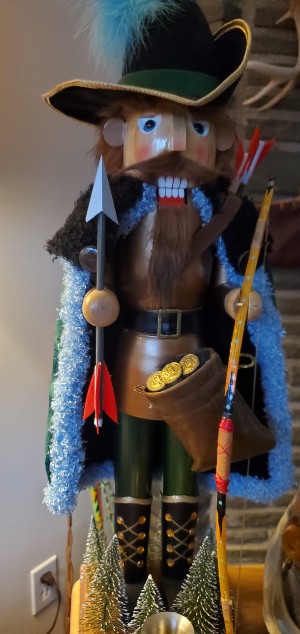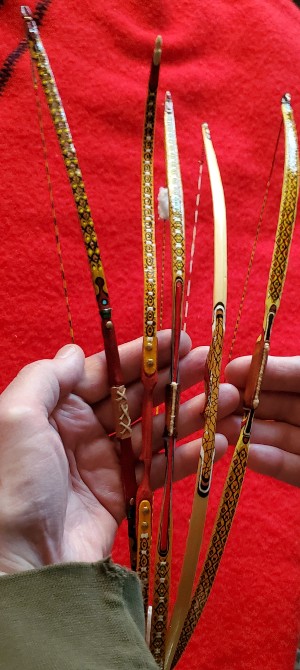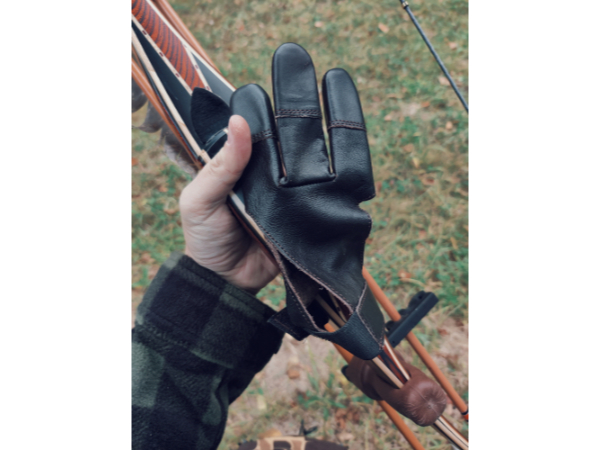I have yet to attempt a full-sized real traditional bow, but one day I will ‘threaten’ to do so. As of now, I am making a series of miniature traditional bows and quivers with fletched arrows. It all started by happenstance.
 My friend Katie gave me a wonderful gift of a wooden archer; a two-foot tall nutcracker statuette from Germany. He came with a green velvet cloak, feathered wide brimmed hat and full attire that an archer would be wearing during the time of the legend of Robin Hood. He also came with a disturbingly badly made bow and just as bad set of arrows in his back quiver.
My friend Katie gave me a wonderful gift of a wooden archer; a two-foot tall nutcracker statuette from Germany. He came with a green velvet cloak, feathered wide brimmed hat and full attire that an archer would be wearing during the time of the legend of Robin Hood. He also came with a disturbingly badly made bow and just as bad set of arrows in his back quiver.
I couldn’t stand the sight of the poorly made archery tackle attached to this finely made representation of Robin Hood. So, without hesitation I took my Dremel tool and cut the bow from his left hand. Whoever designed the statuette really didn’t give it much thought to the “precise” detail his bow and arrows needed. To an archer, this is very important!
I rounded up some of my wooden arrows that were not being used. Some were broken, some cracked, but they were otherwise not shootable. With the heavy use of the Dremel tool, I sanded down approximately 20 inches of arrow shaft to form the basis of a miniature bow. Once the formation of the bow was complete, it took plenty of sanding with a super fine grit sandpaper to get the riser and limbs looking like a full-sized bow. Here’s where I had to be very careful to not take off too much wood on either bow limbs, or too much from the riser section. I found this out quite a few times when the bow snapped in two when stringing it with artificial sinew.
The miniatures still had to be tillered properly just like a real, full-sized working bow. My very good friend, Danny Altamura, fashioned a wooden recurve bow limb press for me. He’s an extremely talented woodworker by trade, and he sure made the process of creating miniatures a lot easier. Submerging the bow into water and soaking it so that the limbs were very pliable, the bow was then locked into the bow press in order to “recurve” the two limbs. A series of ten holes were drilled into the upper and lower parts of the press. Hot air from a blow dryer was used in the drying process. I now know what a real professional bowyer goes through upon the completion of a full-sized hunting traditional bow. Those guys are amazing. My feathered Robin Hood cap goes off to you.
After a day or two, I released the bow from the press and continued the sanding process. It had to be meticulous. Then I could apply the artwork (snakeskin backing) to the limbs that were painted very finely by hand to look like snakeskin, or whatever design that I chose to paint. After the artwork was dry, the bow was then lacquered with five coats of gloss polyurethane. I like super high glossy urethane as it seems to bring out the finest of the smallest lines and figures on the bow.
 Note: The three bows pictured (two longbows and one recurve) are actual replicas of bows that were featured in TRADTIONAL BOWHUNTER® MAGAZINE at one time or another. Longbow by David Dwyer, longbow by Robertson Stykbow, and a Bob Lee recurve. The author owned two of the three bows at one time in the past. The three bows in my art series are titled Three Snakes in The Grass.
Note: The three bows pictured (two longbows and one recurve) are actual replicas of bows that were featured in TRADTIONAL BOWHUNTER® MAGAZINE at one time or another. Longbow by David Dwyer, longbow by Robertson Stykbow, and a Bob Lee recurve. The author owned two of the three bows at one time in the past. The three bows in my art series are titled Three Snakes in The Grass.
The limb tip overlays and additional accents that are present throughout the bow still had to be made separately from the bow itself. This can be overwhelming at best, but necessary if the bow is to be accurate, authentic and precise in appearance of dimension and realism. The same goes for the string. It had to look like it was two or three strands wound like a Flemish twist. The more you do for realism; the bow will start to expose the hidden artistry of the maker.
The deer hides that were used for the miniature quivers were given to me by another good friend and taxidermist from Lake Country Taxidermy, Jeff Moses. Talk about a ‘real’ artist: this guy’s artistry with taxidermy is out of this world! Total museum quality works of art. You’ve all seen great artists before – this guy is one of them, the real deal!
So, there you have it. I brought the broken, discarded missiles of the ‘feathered shaft’ to be reincarnated back to full circle. I turned the arrow into the bow. A miniature keepsake traditional bow to be put up on your mantle in your bowhunter’s den. Trust me on this, every one of my friends that pass by the miniatures has to pick one up to hold it and ‘coo’ over the finely detailed craftsmanship of miniature artistry. They may even give me a pat on the back and ask for one or several of their own.
All Photos by Kate Dohring







I believe i first met Don 4 years ago, and only over the last 2 years got to know him. I am part of the setup and operation of 3 large archery shoots in Pennsylvania, (S.T.A.R, E.T.A.R, PCBF) and i meet alot of people at them yearly. Although very few make an impression like Don Marchaesi. Once you meet Don in person you will never forget him. Not only a great author, but an amazing craftsman aswell.
After 2021 Eastern Traditional Archery Rendezvous (E.T.A.R) Don called me and asked for my address with no context. I gave him my address and he hung up. Three days later i recieved one of his miniature bows, stand, and arrows through the mail. The amount of detail in these bows is outright stunning. The bow is perfect, right down to the tiller. The leather wrapped hand, incredibly detailed backing which is painted on. Don tells me he used a very, very fine paintbrush to accomplish that.
Its not only his attention to detail on the things he can create, but the attention he pays to the things around him. I can only assume that is why he is so proficient in the things he enjoys doing.
I feel honored to not only have him as a friend, but a brother in the world of traditional archery.
P.S,
DO NOT challenge him to a shootoff, you will lose!
I have worked a bit with Don on some articles, and was pleased to meet him in person at ETAR this year. I was also surprised and honored to receive a set of longbow, quiver and arrows on a stand. The craftsmanship is amazing! Is sits in a place of prominence in our home.
I always knew he was an artist and a writer. Talented.